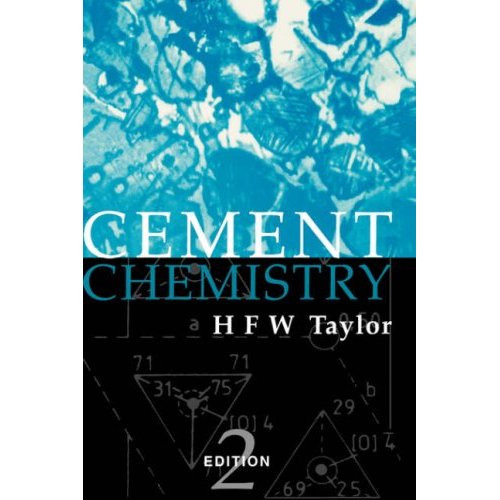
Cement Chemistry By H. F. W. Taylor

Publisher: Academic Press
Number Of Pages: 475
Publication Date: 1990-07
Sales Rank: 5292365
ISBN / ASIN: 012683900X
EAN: 9780126839005
Abstract:
Contents 1. Portland cement and its major constituent phases 1.1 Introduction 1.1.1 Portland cement: general 1.1.2 Types of Portland cement 1.1.3 Chemical chemical nomenclature and other abbreviations 1.2 Alite 1.2.1 Polymorphism and crystal structure 1.2.2 Tricalcium silicate solid solutions 1.2.3 Compositions of alites in clinkers 1.2.4 Polymorphic modifications of the alites in clinkers 1.2.5 X-ray powder patterns and densities of tricalcium silicate and alites 1.2.6 Optical, thermal and other data 1.3 Belite 1.3.1 Polymorphism and crystal structure 1.3.2 Lamellar textures in clinker belites 1.3.3 Polymorphic types of belites in clinkers 1.3.4 Compositions of belites in clinkers 1.3.5 Cell parameters, X-ray powder patterns and other data 1.4 The aluminate phase 1.4.1 Crystal structure: cubic, orthorhombic and monoclinic modifications 1.4.2 Other modifications 1.4.3 Structural modifications of the aluminate phase in clinkers 1.4.4 Compositions of the aluminate phase in clinkers 1.4.5 X-ray poser data, densities and optical properties 1.5 The ferrite phase 1.5.1 Crystal structure and composition in the CA2(AlxFe1-x)2O3 series 1.5.2 Compositions of the ferrite phase in clinkers 1.5.3 Crystal data and X-ray powder patterns for ferrite phase containing foreign ions 1.5.4 Optical, magnetic and other data 2. High-temperature chemistry 2.1 Introduction 2.2 Systems containing CaO with SiO2 or Al2O3 or both 2.2.1 The CaO-SiO2 system 2.2.2 The CaO-Al2O3 system 2.2.3 C12A7 and derived structures 2.2.4 C5A3, C2A and C4A3 2.2.5 The CaO-Al2O3-SiO2 system 2.2.6 Clinker formation in the CaO-Al2O3-SiO2 system 2.3 System containing Fe2O3 2.3.1 The CaO-Al2O3-Fe2O3 system 2.3.2 The CaO-Al2O3-Fe2O3-SiO2 system 2.3.3 Clinker formation in the CaO-Al2O3-Fe2O3-SiO2 system 2.4 Systems containing MgO or FeO 2.4.1 General 2.4.2 Effect of MgO on equilibria in the CaO-Al2O3-Fe2O3-SiO2 system 2.4.3 Phases structurally related to gehlenite 2.5 Systems containing alkalis or SO3 or both 2.5.1 Phases 2.5.2 Equilibria 2.6 Systems with other components 2.6.1 Fluorides and fluorosilicates 2.6.2 Carbonates 2.7 Laboratory preparation of high-temperature phases 3. The chemistry of Portland cement manufacture 3.1 General consideration 3.1.1 Summary of the reactions in clinker formation 3.1.2 Lime saturation factor, silica ratio and alumina ratio 3.1.3 The Bogue calculation 3.1.4 Enthalpy changes in clinker formation 3.2 Raw materials and manufacturing processes 3.2.1 Raw materials and fuel 3.2.2 Dry and wet processes; energy requirements 3.2.3 The dry process; suspension preheaters and precalciners 3.2.4 The rotary kiln 3.2.5 Circulation of volatiles; dust; cooling of clinker 3.2.6 Other processes for clinker production; clinker grinding 3.3 Reactions below about 1300oC 3.3.1 Decomposition of carbonate minerals 3.3.2 Decomposition of clay minerals and formation of products 3.3.3 Sampling from cement kilns or preheater outlets 3.3.4 Reaction mechanism 3.3.5 Condensation or reaction of volatiles 3.4 Reactions at 1300-1450oC 3.4.1 Quantity of liquid formed 3.4.2 Burnabilities of raw mixes 3.4.3 Nodulization 3.4.4 Formation and recrystallization of alite 3.4.5 Evaporation of volatiles; polymorphic transitions; reducing conditions 3.5 Reactions during cooling, grinding or storage 3.5.1 Solidification of the clinker liquid; indications from pure systems 3.5.2 Do Portland cement clinkers contain glass or C12A7? 3.5.3 Evidence from X-ray microanalysis 3.5.4 Effects of cooling rate on the aluminate and ferrite phases 3.5.5 Other effects of cooling rate 3.5.6 Crystallization of the sulphate phases 3.5.7 Changes during grinding or storage 3.6 Effects of minor components 3.6.1 General 3.6.2 Effects of s-block elements 3.6.3 Effects of p- and d-block elements 4. Properties of Portland clinker and cement 4.1 Macroscopic and surface properties 4.1.1 Underground clinker 4.1.2 Particle size distribution of ground clinker or cement 4.1.3 Specific surface area determination 4.1.4 Particle size distribution, phase composition and cement properties 4.1.5 Chemical analysis 4.2 Light microscopy 4.2.1 General 4.2.2 Effects of bulk composition, raw feed preparation and ash deposition 4.2.3 Effects of burning conditions and cooling rate 4.2.4 Applications of light microscopic investigations 4.3 Scanning electron microscopy, X-ray diffraction and other techniques 4.3.1 Scanning electron microscopy 4.3.2 X-Ray diffraction 4.3.3 Chemical or physical methods for separation of phases 4.3.4 Other methods 4.4 Quantitative phase composition 4.4.1 General 4.4.2 Calculation of quantitative phase composition from bulk analysis 4.4.3 Estimation of sulphate phases 4.4.4 Estimation of major phases 4.4.5 Limitations and modifications of the calculation of phase composition 4.4.6 Comparison of results of different methods 4.5 Reactivities of clinker phases 4.5.1 Effect of major compositional variation 4.5.2 Effects of ionic substitutions, defects and variation in polymorph 5 Hydration of the calcium silicate phases 5.1 Introduction 5.1.1 Definitions and general points 5.1.2 Experimental considerations 5.1.3 Calcium hydroxide 5.2 Compositions of C3S and B-C2S pastes 5.2.1 Calcium hydroxide content, thermal analysis and indirect determination of the Ca/Si ratio of the C-S-H 5.2.2 Water content of the C-S-H 5.2.3 X-ray microanlaysis and analytical electron microscopy 5.3 Structural data for C3S and B-C2S pastes 5.3.1 Microstructure 5.3.2 Silicate anion structure 5.3.3 X-ray diffraction pattern, densities and other data 5.4 Structural models for C-S-H gel 5.4.1 General 5.4.2 1.4-nm tobermorite and jennite 5.4.3 C-S-H(I) and similar materials 5.4.4 Products formed in suspensions from C3S or B-C2S 5.4.5 Structural relationships 5.4.6 A mixed tobermorite-jennite-type model for C-S-H gel 5.5 Equilibria 5.5.1 Solubility relations 5.5.2 Species in solution 5.5.3 Thermoch
Review:
Cement chemistry--authoritative, comprehensive...excellent!
The most authoritative book there is for novice and specialist chemists and material scientists in the field of cement chemistry. H.F.W. Taylor, the pope in the field of (applied) cement crystallography, writes clearly and concisely on a topic he has seen develop over the last half century. He demonstrates with great clarity--through the "looking glass" that crystallography provides--how the complex subject of cement chemistry can be understood: how silicate and aluminate cement phases are produced, how they behave hydraulically and the ensuing structure and properties of the hardened materials. This book also boasts a comprehensive bibliography of references, which have been skillfully screened to crystallise the most important literature contributions from the abounding amount that has been produced in this field up to 1996--A needles in the haystack task, very well accomplished. This book is the most comprehensive literature review on the subject!

8.69 mb PDF
روابط الكتاب بالمرفقات
و هذا رابط جديد بتاريخ 1/10/2008
http://www.4shared.com/file/64118646/d9d06198/Taylor_H_-_Cement_Chemistry.html?s=1


